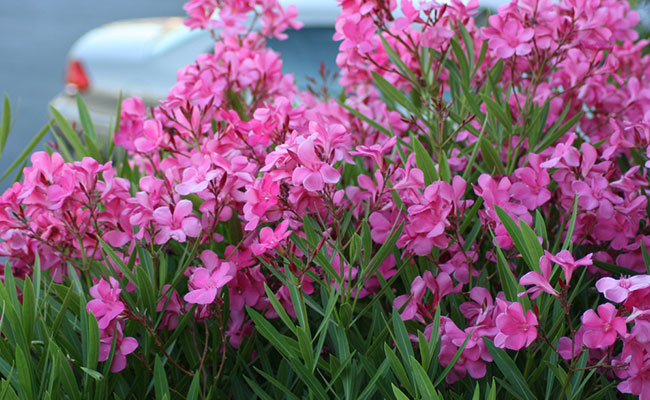The Top 10 Most Poisonous Plants in the World: A Comprehensive List
Plants are a vital part of our ecosystem and are responsible for sustaining life on Earth. However, not all plants are created equal, as some can be deadly to humans and animals if ingested. In this blog, we will be discussing the top 10 most poisonous plants in the world, providing a comprehensive list of their names and the dangers they pose.

Aconite
Aconite, also known as wolfsbane, is a highly poisonous plant found in Europe and Asia. Its roots, leaves, and seeds contain aconitine, a toxin that affects the nervous system and can lead to respiratory failure, paralysis, and death. Even small doses can be lethal, and it has been used historically as a poison for hunting and warfare.

Oleander
Oleander seeds are also highly toxic, containing oleandrin, a cardiac glycoside that affects the heart and can cause irregular heartbeats, seizures, and death. The plant is native to the Mediterranean region and is commonly used as an ornamental shrub in warmer climates. Ingesting just a few seeds can be lethal, and it is the cause of many accidental poisonings in children and pets.

Nightshade
Another plant which comes under dangerous plants is the deadly nightshade, also known as belladonna. It is a common plant found in Europe and North America. All parts of the plant, especially berries, contain atropine and scopolamine, which can cause hallucinations, delirium, convulsions, and death. The plant has been used in witchcraft, and its extracts have been used for medicinal purposes such as pain relief and dilation of the pupils.

Manchineel Tree
The manchineel tree, native to the Caribbean and Central and South America, is often referred to as "the tree of death" due to the highly toxic sap it contains. The sap can cause severe skin irritation and blistering, and even standing under the tree during a rainstorm can lead to chemical burns. Ingesting any part of the tree, including the fruit, can cause abdominal pain, vomiting, diarrhoea, and potentially death due to the toxins it contains.

Water Hemlock
Water hemlock, also known as cowbane, is one of the deadliest plants in North America. It contains cicutoxin, a neurotoxin that affects the nervous system and can lead to seizures, respiratory failure, and death. The plant is found in wetlands and along stream banks and is often mistaken for edible plants such as wild carrots or celery. Ingesting just a small amount can be lethal, and there is no known antidote for its poison.

Toxicodendron
Toxicodendron, also known as poison ivy, poison oak, and poison sumac, is a common plant found throughout North America. Its leaves and stems contain urushiol, an oily resin that causes an allergic reaction in most people, leading to redness, itching, and blistering. In severe cases, it can cause difficulty breathing and swelling of the throat, and if ingested, it can lead to internal inflammation and damage to the digestive system.

Strychnine tree
The strychnine poisonous tree, also known as the poison nut, is native to India and Southeast Asia. Its seeds contain strychnine, a powerful neurotoxin that affects the nervous system and can cause convulsions, muscle spasms, and death. Historically, the seeds were used as a poison for hunting and warfare, and in small doses, it has been used as a stimulant and pain reliever.

Datura
The poisonous plants list includes Datura, also known as jimsonweed or devil's trumpet, is a highly toxic plant found in tropical and temperate regions of the world. Its leaves, seeds, and flowers contain scopolamine, hyoscyamine, and atropine, which can cause hallucinations, delirium, confusion, and death. The plant has been used historically for medicinal and religious purposes, but its toxicity makes it a dangerous plant to consume.

Lily-Of-The-Valley
Lily-Of-The-Valley is a beautiful and sweet-smelling flowering plant that is often associated with love and happiness. Despite its popularity and use in expensive bouquets and the wedding of the Duchess of Cambridge, this plant is highly toxic. Its toxic properties stem from a high concentration of cardiac glycosides that can lead to heart problems and even death if consumed.

Rosary Pea
The jequirity bean, also known as the Rosary Pea, is a climbing plant from the Fabaceae family that is native to Asia and Australia but has become invasive in various regions, including parts of the Caribbean and the USA. Despite its small size, the beans of this plant are extremely toxic and can cause serious harm, even death, if ingested. The jequirity bean is often used as an ornamental plant due to its beauty and holds cultural and religious significance in various countries.

It is essential to be aware of the dangerous plants that exist in our environment to avoid any accidental ingestion or exposure. The plants discussed in this blog, including aconite, deadly nightshade, oleander seeds, manchineel tree, water hemlock, Toxicodendron, strychnine tree, hemlock plant, poisonous hemlock, and datura, are among the most poisonous plants in the world, with lethal effects on humans and animals. It is important to exercise caution and avoid consuming any unknown plant or parts of a plant and seek immediate medical attention if accidental ingestion occurs. So, next time when you buy plants online make sure to do proper research and choose the right lush green plants for your living space.















